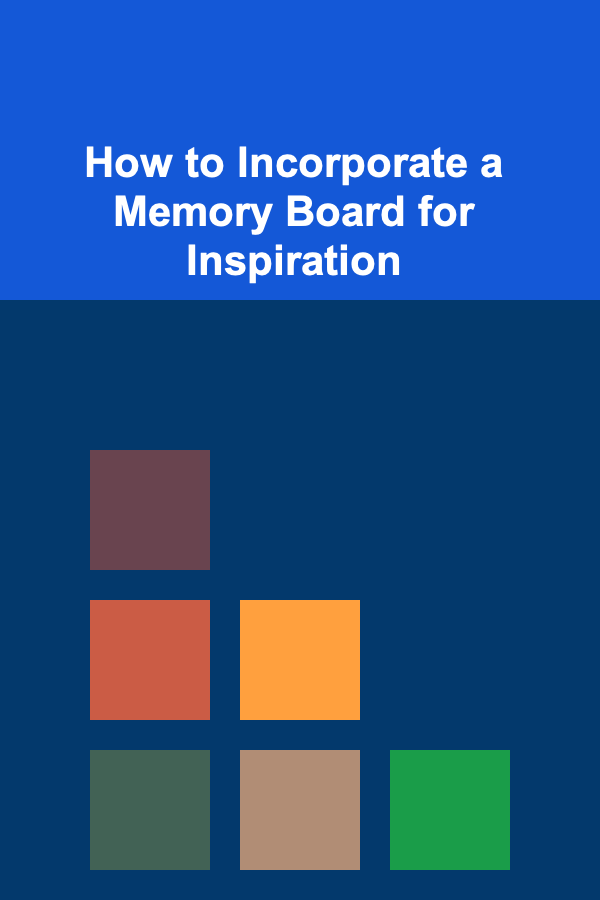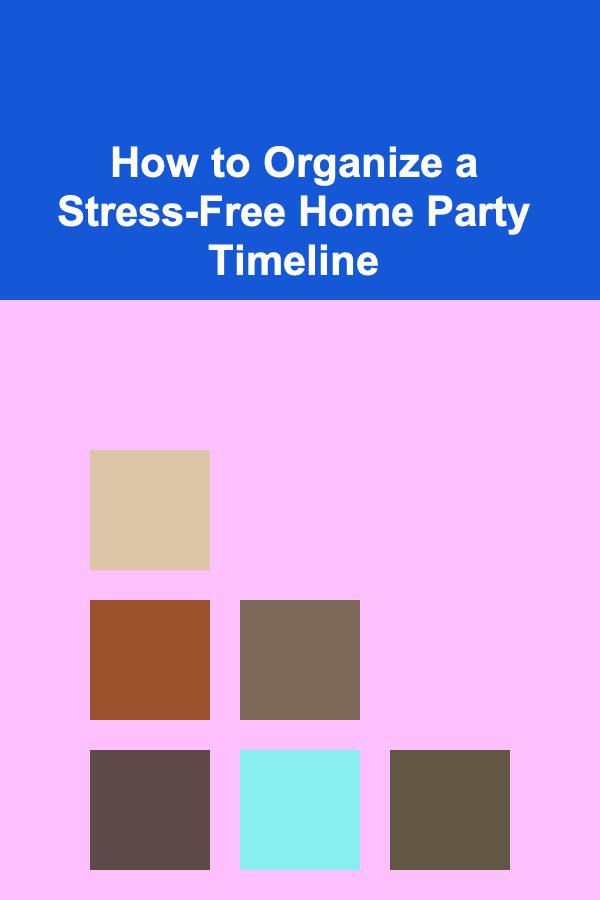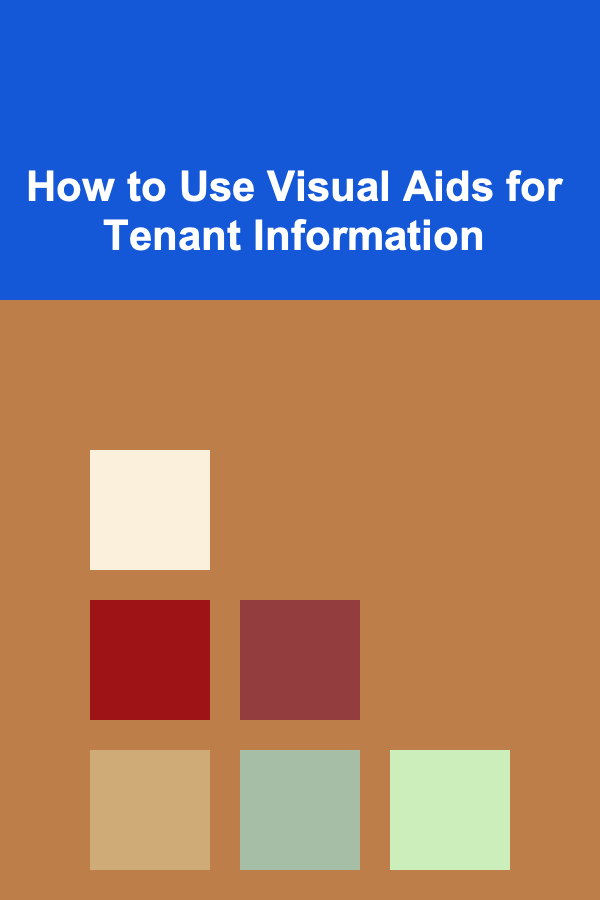
How to Incorporate a Memory Board for Inspiration
ebook include PDF & Audio bundle (Micro Guide)
$12.99$7.99
Limited Time Offer! Order within the next:

In the dynamic world of creativity and self-expression, finding inspiration can sometimes be a struggle. Whether you're an artist, a writer, a designer, or anyone engaged in a creative endeavor, having a dedicated space for inspiration can significantly enhance your workflow and productivity. A memory board---often referred to as a vision board, inspiration board, or mood board---is an effective tool that not only helps to organize thoughts but also serves as a visual reminder of goals, dreams, and aspirations. In this detailed guide, we will explore how to incorporate a memory board into your creative process, providing you with actionable steps and ideas to foster inspiration.
Understanding the Concept of a Memory Board
A memory board is essentially a physical or digital space where you collect and display images, quotes, clippings, and other materials that inspire you. It's a collage of visual stimuli that serves as a source of motivation and creativity. The concept is rooted in the idea that visualization can help you achieve your goals and manifest your dreams.
Components of a Memory Board
- Images: Photographs, illustrations, or artwork that resonate with you.
- Quotes: Inspirational phrases or affirmations that uplift your spirit.
- Clippings: Magazine cutouts, fabric swatches, or other tactile materials.
- Personal Items: Mementos or souvenirs that hold special meaning.
Benefits of Using a Memory Board
1. Visual Motivation
A memory board provides constant visual reminders of your goals and aspirations. Seeing these elements regularly can boost motivation and keep you focused on what matters most.
2. Enhanced Creativity
Surrounding yourself with inspiring visuals can stimulate creative thinking. Often, the mind connects dots between seemingly unrelated ideas when presented with diverse stimuli.
3. Goal Clarification
Creating a memory board forces you to think critically about what you want to achieve. This process helps clarify your goals and refines your focus.
4. Emotional Connection
A memory board allows you to express emotions and experiences through visual representation. This emotional connection can serve as a powerful motivator during challenging times.
5. Aesthetic Appeal
Beyond functionality, a well-crafted memory board can add aesthetic value to your workspace. It becomes a piece of art in itself, reflecting your personality and creative journey.
Types of Memory Boards
Memory boards come in various formats, each serving different purposes based on personal preference and available space.
1. Corkboard
A classic choice, corkboards allow you to easily pin items and rearrange them as needed. They offer flexibility and adaptability.
2. Magnetic Board
Magnetic boards are versatile and modern. You can use magnets to attach items, making it easy to swap out components without leaving holes.
3. Canvas Board
Canvas boards provide a more artistic touch. They allow for gluing items directly onto the surface and offer a textured, painted background.
4. Digital Boards
Digital memory boards can be created using design software or apps like Pinterest, Trello, or Canva. They allow for easy sharing and accessibility across devices.
5. Vision Board
Often used interchangeably with memory boards, vision boards focus specifically on long-term goals and aspirations. They tend to have a motivational aspect that encourages manifestation.
Choosing the Right Location
The location of your memory board is crucial to its effectiveness. Here are some considerations:
1. Visibility
Place your board in a location where you'll see it regularly. This could be above your desk, near your workspace, or even in your bedroom.
2. Size
Consider the size of your board in relation to your space. Ensure that it's large enough to accommodate your ideas but not so large that it overwhelms the environment.
3. Accessibility
Choose a spot that's easy to access, allowing you to update and modify your board as needed. This flexibility encourages regular interaction.
4. Lighting
Good lighting enhances visibility and makes colors pop. If possible, position your board near natural light or ensure adequate artificial lighting.
Gathering Materials for Your Memory Board
Creating a memory board requires various materials, depending on the type you choose. Here's a comprehensive list of items you might need:
Basic Materials
- Board: Corkboard, magnetic board, canvas board, or digital platform.
- Adhesives: Push pins, magnets, glue sticks, double-sided tape, or staples.
- Cutting Tools: Scissors or craft knives for trimming images and materials.
Decorative Elements
- Background Papers: Colored or patterned paper to use as a backdrop.
- Embellishments: Stickers, washi tape, or ribbon for added flair.
- Markers/Pens: For writing quotes or labels on your board.
Source Materials
- Magazines: For clippings and images that resonate with your goals.
- Printouts: Downloaded images, quotes, or templates from online sources.
- Personal Photos: Images that reflect moments of joy, achievement, or inspiration.
Creating the Memory Board
Now that you have gathered your materials, it's time to create your memory board. Follow these steps:
1. Design Your Layout
Before attaching anything, lay out your items on the board to determine the best arrangement. Play around with different configurations until you find one that feels right.
2. Create a Background
If desired, start by creating a cohesive background using color or texture. This step adds depth and visual interest to your board.
3. Arrange Items
Begin placing your images, quotes, and clippings on the board. Start with larger items and build around them with smaller accents.
4. Secure Everything
Once satisfied with the layout, secure each item in place using the chosen adhesives. Take care not to overcrowd; leave some negative space for balance.
5. Personalize
Add personal touches, such as handwritten notes or drawings. This step infuses your unique personality and style into the board.
6. Hang or Display
If creating a physical board, hang it in your chosen location. If working digitally, consider sharing it on social media or keeping it on a cloud service for easy access.
Incorporating a Memory Board into Your Daily Routine
To maximize the benefits of your memory board, integrate it into your daily life:
1. Morning Ritual
Start each day by spending a few moments reviewing your memory board. Reflect on your goals and remind yourself of the inspiration it holds.
2. Creative Breaks
During breaks, take time to engage with your memory board. Explore new ideas and let the visuals spark your creativity.
3. Reflection Time
Set aside time weekly to assess your progress toward your goals. Use your memory board as a reference point for reflection and evaluation.
4. Regular Updates
Make it a habit to update your board regularly. Replace outdated images or quotes with fresh ones that align with your current aspirations.
Updating and Maintaining Your Memory Board
Keeping your memory board relevant requires ongoing attention:
1. Seasonal Changes
Consider updating your board with seasonal themes, colors, or inspirations. This practice can keep your creative energy flowing throughout the year.
2. Evolution of Goals
As your goals evolve, so too should your memory board. Periodically reassess what's on there and curate it according to your current objectives.
3. Condition Check
If using a physical board, check the condition of items regularly. Replace or repair damaged components to maintain its visual integrity.
4. Cleanliness
Dust off your board periodically to keep it looking fresh. A tidy presentation enhances its impact and keeps your workspace inviting.
Common Challenges and Solutions
Challenge: Lack of Inspiration
Solution: If you're feeling uninspired, seek new sources of inspiration---visit art galleries, read books, or browse online platforms. Collect fresh materials for your board.
Challenge: Overcrowding
Solution: Keep your board organized by enforcing a "one-in, one-out" rule. Add a new item only if you remove an old one.
Challenge: Difficulty Finding Relevant Items
Solution: Create a dedicated folder on your computer or a box for physical items to store potential additions. Regularly revisit this collection to refresh your board.
Challenge: Time Constraints
Solution: Set aside specific times for board updates, treating them as mini-projects rather than chores. Even 15 minutes can make a difference!
Case Studies: Successful Use of Memory Boards
Case Study 1: Emily the Artist
Context: Emily, an aspiring painter, struggled to find direction in her work and often felt disheartened by creative blocks.
Solution: She created a vibrant memory board filled with images of landscapes, color palettes, and inspirational quotes from famous artists. This became her go-to for motivation during painting sessions.
Outcome: Emily reported a newfound creativity and focus. Her artwork flourished, and she completed several pieces that were showcased in a local gallery.
Case Study 2: Mark the Entrepreneur
Context: Mark was launching a startup but found it challenging to stay motivated amid setbacks.
Solution: He developed a memory board highlighting his business goals, customer testimonials, and industry trends. This physical reminder kept him anchored in his mission.
Outcome: The memory board served as a continuous source of encouragement. Mark successfully launched his startup and credits his board for maintaining clarity and purpose.
Conclusion
Incorporating a memory board into your creative routine can profoundly impact your ability to find inspiration and stay motivated. By understanding its benefits, choosing the right materials, and integrating it into your daily life, you can cultivate an environment that fosters creativity and personal growth.
Whether you opt for a physical board adorned with images and quotes or a digital version accessible at any time, the key lies in nurturing this resource. Regular updates, reflection, and engagement with your memory board will keep it relevant and supportive of your aspirations.
Ultimately, a memory board is more than just a collection of visuals; it's a testament to your dreams and the journey you undertake to reach them. Embrace the process, and watch as your creativity flourishes. Happy creating!
Reading More From Our Other Websites
- [Personal Care Tips 101] How to Use Toothpaste to Fight Gingivitis
- [Personal Investment 101] Maximizing Earnings with AI and Deep Learning-Based Products
- [Home Renovating 101] How to Plan a DIY Home Renovation Project from Start to Finish
- [Mindful Eating Tip 101] The Science Behind Mindful Eating Affirmations and Their Impact on Digestion
- [Hiking with Kids Tip 101] Top % Family‑Friendly National Parks for Memorable Hikes
- [Beachcombing Tip 101] 10 Essential Beachcombing Rules Every Coastal Explorer Should Know
- [Home Storage Solution 101] How to Organize Your Bathroom with Limited Space
- [Home Budget 101] How to Use Meal Planning to Save on Home Expenses
- [Metal Stamping Tip 101] How to Optimize Die Design for Complex Geometries in Metal Stamping
- [Home Staging 101] How to Stage Your Home on a Budget Without Compromising Quality

How to Build a Strong Foundation for Home Maintenance Success
Read More
How to Master Algorithms for Interviews
Read More
How To Master Public Relations for Marketing
Read More
How to Organize a Stress-Free Home Party Timeline
Read More
How to Protect Your Home from Seasonal Wear and Tear
Read More
How to Use Visual Aids for Tenant Information
Read MoreOther Products

How to Build a Strong Foundation for Home Maintenance Success
Read More
How to Master Algorithms for Interviews
Read More
How To Master Public Relations for Marketing
Read More
How to Organize a Stress-Free Home Party Timeline
Read More
How to Protect Your Home from Seasonal Wear and Tear
Read More